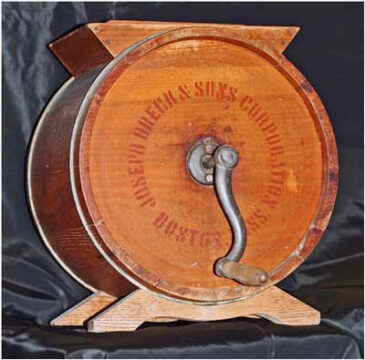
The Rosenberg Library Museum displayed a late nineteenth century barrel butter churn as the November Treasure of the Month. Purchased from Mr. Ed Howe of Coopers Mills, Maine, this butter churn was used in the Texas frontier during the late 19th and early 20th centuries. It was made by the agricultural and seed firm Joseph Breck and Sons of Massachusetts. Mr. Breck was frequently touted as a horticultural revolutionary and his company was considered the leading seed supply on the East Coast.
Barrel butter churns were agricultural innovations of the 18th century in Europe and operate via a hand crank to turn paddles within the barrel.
Butter is produced by agitating cream, which can be made from the milk of several mammals including buffaloes, yaks, sheep, goats, and cows. Agitation of the cream allows the butter to clump together to produce butter “grains.” The butter grains are then kneaded to remove any remaining liquid, known as buttermilk, and consolidate the grains into one deliciously spreadable mass.
In antiquity, butter had many uses beyond its current condiment status. Butter was eaten, was used as illumination oil, used for medicinal purposes, and rubbed on skin as insulation from bitter cold. The all-purpose substance was brought to Southern Asia through conquest and colonization via horseback by 2000 BC from the Fertile Crescent area of southern Mesopotamia (present-day Iraq).
In the 17th and 18th centuries, Ireland was the major exporter of the product to northern Europe and the Americas. It was common practice in Ireland to pack butter into barrels (or firkins) and bury them in peat bogs. Bog butter was praised for its strong flavor as it aged and remained edible in this peculiar environment thanks to the antiseptic and acidic qualities of the bog. Many of these firkins are still being found today and can be viewed within Irish history museums. The Industrial Revolution made the Irish method obsolete, but butter making is still a cherished tradition and a major export of the Emerald Isle.
Butter churns, devices which help to agitate the cream and knead the butter grains, come in many shapes and sizes and have sometimes even been used for unconventional purposes. The oldest form of butter churn is the rocker churn. Made of goat skin bags, gourds, or even glass jars, these simple vessels have been used to agitate cream for thousands of years and were operated via shaking or rocking – hence the name. Paddle churns, such as the one on display, were glass or wooden containers with interior paddles operated by an outside handle. During the Civil War, Confederate troops experimented with the butter churns as explosives, but were found to be unsuccessful. Commercial butter churns, first developed in Europe in the 1930s, are now used in dairy factories all over the world and can produce over a ton of butter per hour!
Have you ever tried to make butter at home? It’s not as hard as one might think and can be a fun family event during the holiday season. Here are some easy and family-fun links to recipes:
Best instructions for bigger quantities of butter: http://www.ehow.com/how_5815_make-butter.html
Simple apple butter recipe: http://www.recipetips.com/recipe-cards/t–1953/apple-butter.asp
Pumpkin butter: http://allrecipes.com/Recipe/Pumpkin-Butter/Detail.aspx
Butter recipe for those who want the scientific breakdown AND pictures!: http://www.cookingforengineers.com/article/113/Making-Butter